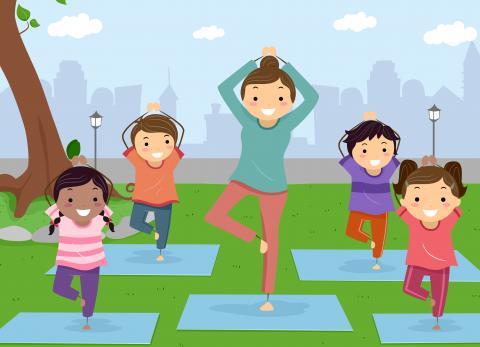
As Director of an after-school program, I have worked with children for many years. During this time, I have come to appreciate the many benefits of yoga for kids. After-school programs offer many varied enrichment opportunities (as they should), but the yoga classes stood apart.
Following a day cooped up at their desks, children usually came to the program rambunctious and with the day’s pent-up energy and frustrations. I would send them into their class with silent sympathy for the yoga teacher. They came out an hour later noticeably tranquil and calmed.
How is this magic achieved?
In fact, as it turns out, it is not magic - and we can understand it by looking at a few of the benefits of yoga for children:
- Breath awareness. Focus on the breath relaxes children by bringing the focus to the breath. Giving kids the ability to self-calm through breathing and focus is a huge benefit, not just during the yoga class; learning to focus on the breath can be used as a tool later in life during stressful times.
- Balance. This requires focus and encourages coordination.
- Strength. A strong body is a healthy body. Every body function is improved with increased strength, from digestion to weight management to a lower blood pressure.
- Non-competitive. In an age when kids compete in so many areas of their lives, not just in sports but also in the classroom, this is an opportunity to participate in an activity with a level playing field. They feel safe here and do not have to worry about performance or the judgment of their peers.
- Increased confidence. Children take pride in seeing their progress as they master poses. A healthy body leads to self-confidence and a strong body image.
- Builds concentration. As students focus on maintaining poses, concentration develops naturally.
- Body awareness. Children learn how to listen to their body and become aware of how it should feel.
- Anatomy awareness. It is a great opportunity to teach anatomy and identify muscle groups, especially for older students.
- Fun. The best part? They have fun! When taught through games, kids don’t even realize all the above benefits – they are simply having fun.
A good instructor will employ all sorts of games into the class. There is no shortage of ways to make learning poses fun, from musical yoga mats (when the music stops students have to do whatever pose the instructor calls out), to randomly selecting poses from illustrated cards. Breathing can be explored using straws and blowing gently to lift a feather. Children love focusing on different scents and oils.
Increasingly, children are shuttled from school to one activity after another, and while much of this is fun and is motivated by the best of intentions, we should not forget that it can be very stressful - particularly in competitive fields. Amid all the enforced directed activities, kids are in danger of losing the ability to just “be”.
And that is where yoga comes in – to remind kids to just be, to encourage unbridled fun, and to increase awareness of themselves and their environments.








